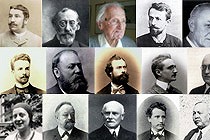
|
Research Results Primary Research Results Intensive and thorough research has enabled us to close key research gaps as well as to make basic details available for more profound analytical study or as a basis for more extensive research. A total of around one third of the architects included in the lexicon are documented for the first time, among these are architects who were proactive and very successful in their own lifetimes, and whose work is significant for the urban fabric of Vienna to this day (e.g. Ludwig A. Fuchsik, who built around 30 apartment buildings and commercial premises in Vienna, or Alois Koch, who built the Universität für Bodenkultur/Vienna University of Natural Resources and Applied Life Sciences). For the first time, architects who are documented in contemporaneous lexica or reference works, but also in more recent lexica, with only extremely sparse details have complete entries dedicated to them and their work. (E.g. Arthur Baron, 15.5.1874 – 30.8.1944, whose entry in the 'Allgem. Künstlerlexikon' states "active circa 1903–1913"; Adolf Ambor, 28.3.1891 – 15.5.1912, whose entry in the same reference book merely states "active in 20th century Vienna".) Incorrect ascriptions have been clarified, as have various misunderstandings as a result of similar names or mix-ups (e.g. the municipal director of building Franz Berger born in 1841, and regional director of building Franz Berger born in 1853 are entered as one and the same person in all previously available reference works). Incorrect information or inconsistencies in details provided in different sources have been corrected (e.g. Gustav Korompay 4.1.1833–17.2.1907, incorrect birth dates in H. Fuchs: Die österreichischen Maler des 19. Jhs. (1973); as well as in the Allgemeines Künstlerlexikon, Bio-Bibliographischer Index (2000); ThB (1907ff); H. Kosel: Deutsch-österreichisches Künstler- und Schriftsteller-Lexikon (1902); L. Eisenberg: Das geistige Wien (1891)) The correct architectural authorship could be clarified for the first time of around 900 objects, predominately apartment buildings and commercial premises, and villas. In the detailed CVs, as well as in the descriptions of the relevant architects' approaches to their work, not only is the architecture historical context shown but for the first time at least the basic additional facts relating to relevant socio-political factors, cultural history and urban development. Secondary Research Results The innovative standards applied to the 'Architektenlexikon' required progressive intensification of international academic exchange and cooperation (e.g. contact to academic facilities in the USA, France, Germany and Switzerland). In particular, contact was made with academics in the former 'Crown lands', i.e. the countries of East Europe, resulting in some cases in intensive collaboration work. Furthermore, fruitful mutual relationships resulted from the work on specific issues with domestic institutions too, such as the Bundesdenkmalamt (Austrian Federal Monuments Office). The comprehensive treatment of the material and the clear presentation of the individual entries have made the 'Wiener Architektenlexikon 1880–1945' accessible to a broad public. The database is made use of by specialist academics and students, as well as by interdisciplinary academics and students of other disciplines — such as historians or cultural scientists. It is also used by architects, for instance, and conservationists as well as private individuals. A large quantity of feedback in Austria and from other countries shows that the lexicon has in the meantime also achieved a high level of awareness and is viewed extremely positively. Not least, the high degree of interest in the lexicon and the positive international response to it helped in the inclusion of information from new sources that were either unknown to date or difficult to access, and so the interplay between research and practise was used beneficially to ensure a high standard. Accordingly, too, new and helpful information reached us from surviving family members of the architects concerned — spread throughout the world. In addition, many individuals who, for instance, had conducted researched into a particular work by an architect or have an interest in an architect in a specialist context also provided valuable supplementary information. The publication and the ongoing expansion of the lexicon of architects have raised and strengthened the profile of the Architekturzentrum Wien as a centre of expertise and a source of reliable information for issues relating to architecture history and architecture theory, on both a domestic and an international level. |
 |
|
© Az W |
|
Encyclopaedia of Architects - Structure - Online Service - Project Team - Research Results - List of Architects - Acknowledgments Educational Facilities Index of Archives Literature Links: Encyclopaedia of Architects, Vienna 1770 - 1945 Information: Sonja Pisarik Tel.: +43 (1) 522 31 15 - 26 Fax: +43 (1) 522 31 17 Email: pisarik@azw.at Katrin Stingl Tel.: +43 (1) 522 31 15-37 Fax: +43 (1) 522 31 17 Email: stingl@azw.at Monika Platzer Tel.: +43 (1) 522 31 15 - 21 Fax: +43 (1) 522 31 17 Email: platzer@azw.at |
| © Architekturzentrum Wien 2025 |
||



